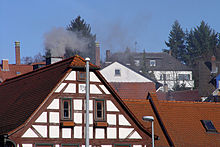House fire (fuel)
As domestic fuel is fuel for use in small furnaces in households , such as the stove , fireplace , stoves , central heating u. Ä. As well as its combustion .
The designation for solid fuels such as firewood (as split logs or wood pellets ) and coal (in pieces or as briquettes ) is particularly common . In the case of liquid or gaseous fuels, however, the designation as domestic fuel is less common.
history

Historically, house fires were mostly renewable raw materials, but often also low-quality, cheap fuel or even waste, while the higher-quality fuels were used more for commercial and industrial applications. Wood is mankind's oldest fuel. So the inferior harvesting wood and the cut waste from the forest were allowed to be collected for house fire up to modern times . Since early industrialization, the use of coal, which was soon to become the most important fuel in some countries, has also spread. In some regions, peat and cow dung were and are also used - in some cases up to the present day .
In coal mining it was and is customary for the miners to receive a deposit of coal as house fire.
As a result of the smog catastrophe in London in 1952 , the "Clean Air Act" was passed, a bundle of measures to combat air pollution, whereby above all the number of open chimneys was to be drastically reduced. In some countries, different legal regulations apply to domestic fires in terms of taxation and emission limit values compared to industrial firing.
Taxation in Germany has been regulated in the Energy Tax Act since 2006 , although coal as a domestic fuel initially remained tax-exempt. The ordinance on small and medium-sized combustion systems (1st BImSchV) has been in force since 1988, stipulating that only low-smoke solid fuels may be used in domestic fires, namely coal, lignite, burnt peat, peat briquettes and natural wood that has been dried for at least 2 years.
Ecological aspects
In Austria and some other countries, such measures are justified, among other things, by the fact that house fires, especially in regions with many older, solid-fuel-fired stoves, contribute significantly to the pollution of the environment with fine dust .
On average across the EU, domestic heating contributes 27% to PM 2.5 emissions and 19% to PM 10 emissions. It ranks first among the issuers, although a clear downward trend has been observed since 2000. A related study is also used in the discussion about the introduction of environmental zones .
See also
Individual evidence
- ↑ Fuels at http://www.energiesparmobil.de ( Memento from May 18, 2006 in the Internet Archive ) (PDF file; 101 kB)
- ↑ Fine dust in Austria
- ↑ European Environment Agency: European Community emission inventory report 1990-2007 under the UNECE Convention on Long-range Transboundary Air Pollution (LRTAP) . Office for Official Publications of the European Communities, Luxembourg 2009. ISBN 978-92-9213-005-3 . ISSN 1830-8139 . EEA Technical report series: ISSN 1725-2237 . doi : 10.2800 / 12414 , pages 41 and 44, accessed on August 28, 2018.